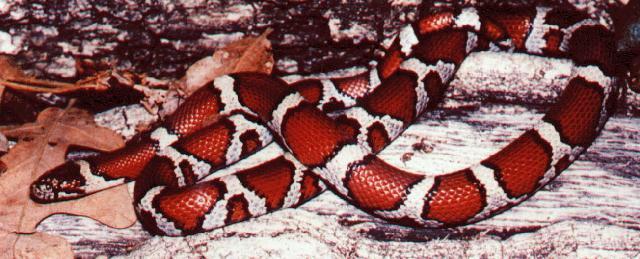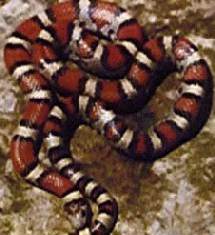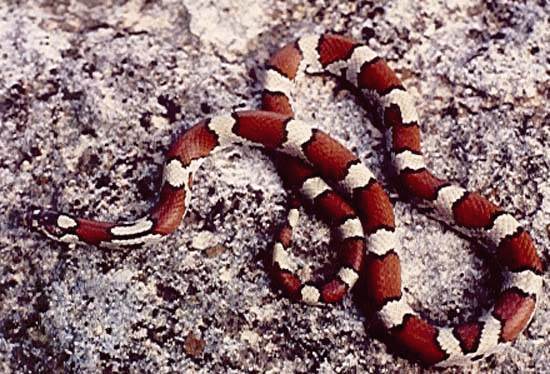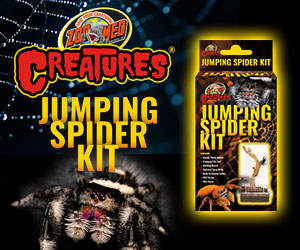
- Red Milk Snake
- Lampropeltis triangulum syspila
- Size:
- Hatchling: 6 - 8.5 in.
- Adult: 18 - 28 in.(normal) 42 in.(record)
- Scalation:
- Dorsal: 21 rows
- Ventral: 170 - 212
- Sub caudal: 37 - 51
- Infra labial:8 - 10
- Supra labial: 7
- Anal Plate: Single
|

Photo courtesy Troy Hibbitts
click to enlarge |
Written by Matt Ingrasci
- Coloration
- A richly colored tri-colored Milksnake with wide red rings borderd in black on a whitish background.
- Head:
Head pattern varies greatly; in most animals the head is marked by a large red blotch--edged in black. The snout, labials, and chin are cream colored with black at the sutures. A pair of supraocular light spots infringe on the red dorsally; sometimes the spots connect to form a narrow, light-colored crossband which transects the red.
- Dorsal:
The body pattern also varies; typically display from 19-30 crimson, red-brown, or rust colored dorsal saddles margined with black. The ground color varies between white, gray, cream, and tan. Dorsal blotches extend ventrally to the second or first scale rows, occasionally reaching the sides of the ventrals. A row of lateral spots occurs ventrolaterally; this row may be prominent on some specimens while almost absent on others. The black spots usually contain red centers, but not always. On the tail, the dorsal blotches extend onto the venter, becoming rings that number 4 to 8. The young exhibit the adult pattern but often display brighter colors.
- Ventral:
The ventral scales are marked white with a varying amount of black checkerboard. Red is absent in most specimens.
- Range:
- Eastern Kansas through Missouri, so. Illinois, sw. Indiana, Kentucky and w. Tennessee. From so. Iowa south into n. Arkansas.
- Habitat:
- Red milks have been taken in a variety of situations. Bluffs, timbered ledges, and south-facing rocky hillsides seem to produce these snakes in numbers; cedar glades have proven especially productive as well. These snakes can often be taken under tin or other miscellaneous rubbish in outlying areas as the snakes move away from hibernacula in search of food. Frequently, red milks live in association with ringnecks and worm snakes.
- Prey:
- In the wild, red milks feed on skinks (Eumeces, Scincella), fence lizards (Sceloporus), worm snakes (Carphophis), earth snakes (Virginia), and various rodents. Prey is killed by constriction. Lizards appear to make up the major part of the diet along with rodents; snakes seem to be taken less frequently. In captivity, red milks will usually accept a diet of mice though an occasional specimen will insist on eating only lizards. Various techniques, such as scenting, should persuade any problem feeders to take more readily available prey items.
.
- Behavior:
- The activity period for red milks begins in early to mid-April and tapers off in October with most activity occurring in April, May, and September. Red milks have seldom been taken during the hottest part of the season. Breeding occurs in spring; gravid females lay from 1-12 eggs in June and July. Hatching takes place mid-August through September. For the most part, red milks lead a subterranean lifestyle and have rarely been found out in the open. Especially in rocky areas, the snakes utilize an underground network of cracks, crevices, and animal burrows; they come to the surface to feed and thermoregulate under sun-baked rocks.
- Breeding:
-
Red milks should be kept like other temperate triangulum and have no special requirements. Due to their secretive nature, providing a means of security (hide box) is encouraged. Specimens do well in captivity; wild caught adults acclimate fairly easily, though some never become consistent feeders even when treated for parasites. The notoriously small hatchlings have a reputation for being difficult to feed. A pinkie pump or similar tube-feeding device becomes an indispensable tool (along with patience) as often the smaller snakes cannot take even a newborn mouse. For this reason these beautiful snakes have been neglected in mainstream herpetoculture--where their larger, more hardy cousins predominate. Captive breeding presents no challenges over other triangulum; successful propagation requires a brumation period of approximately three and a half months.
- Literature Cited:
- Stebbins,Robert C. 1985 second editition revised. A field guide to Western Reptiles and Amphibians. Houghton Mifflin Company

Wyandotte County, Kansas
Photo by Kirk Setser
Click to Enlarge |

Jefferson County, Missouri
Photo by Kirk Setser
Click to Enlarge |
|
|
Sponsored Link
New & Updated Business Listings
Looking for a reptile or amphibian related business? A reptile store, breeder, importer,
maunfacturer or supplier? Our business directory lists some of the most popluar herp businesses in the world.
| Locate a reptile or amphibian business by name:
|
|
Recent Milk Snake Forum Forum Posts
• I'm here, too!, posted by Sunherp
• Kingsnake lives!, posted by exposito
• Hey Everybody, I'm here., posted by AaronBayer
• Scott Ballard Provided A Wealth Of Info, posted by Ameron
• Central America Milksnake Dilemma, posted by Ameron
• Retun to Forum / New Stuart's Milksnake , posted by Ameron
• Eggs ok?, posted by highley1980
• Splotched Sinaloan Variety, posted by bslugger551
• Splotched/Bullseye Sinaloans, posted by bslugger551
• Is my milk snake is getting TOO HOT?, posted by darbellah
• New owner looking for advice, posted by Irishfran
• New adoption biting and chewing fingers, posted by ajcur17
• Help*** Our milksnake won’t eat., posted by KieranSnake
• "trouble" with my milk snake, posted by kedjkd
• L. annulata (Mexican Milk) temps, posted by JJJ
Recent Milk Snake Classifieds:
- WANTED Milksnakesall spe...
Banner Pool
|














